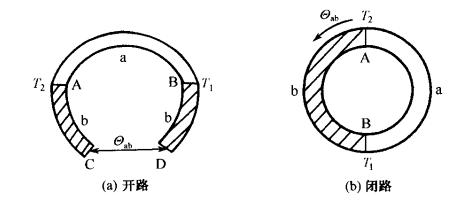Professional Knowledge Introduction
- Categories:服务支持
- Time of issue:2017-11-30 00:00:00
- Views:0
Seebeck Effect

As shown in the figure, when two different conductors a and b are connected at both ends to form a closed circuit, if the two joints A and B have different temperatures, there will be current in the circuit. This current is called thermoelectric current , This loop constitutes the so-called thermocouple, the electromotive force that produces the current is called thermoelectromotive force, and its value is generally only related to the temperature of the two joints. This effect was discovered by Seebeck in 1821, so it is called the Seebeck effect, and the thermoelectromotive force is also called the Seebeck electromotive force.
Thermal conductivity of semiconductors
When the temperature of a certain part of the crystal rises, the heat energy will be conducted from the high temperature part of the crystal to the low temperature part, so that the temperature of the whole crystal tends to be uniform. Take a one-dimensional case as an example, imagine a small area ds in the crystal, and the temperature gradient of dT / dx along the x direction, then the heat Q through the area ds and the area ds, the temperature gradient dT / dx and time in dt time dt is proportional to

The minus sign indicates that the heat flows from high temperature to low temperature; k is called the thermal conductivity of the crystal, and the unit is:W/(m▪K)。
Hall Effect
Put a current-carrying semiconductor in a uniform magnetic field, set the electric field along the X direction and the electric field strength as Ex; the direction of the magnetic field is perpendicular to the electric field, along the z direction, and the magnetic field induction strength is Bz. The -y direction will produce a transverse electric field Ey, this phenomenon is called the Hall effect. Hall electric field Ey is proportional to current density Jx and magnetic field induction intensity Bz, namely
Ey=RHJxBz
The proportional coefficient RH is called the Hall coefficient, namely

(Source: Seventh Edition of "Semiconductor Physics" Electronic Industry Press)
Magnetic Field
(International Electrotechnical Commission IEC's definition) The components of the electromagnetic field are characterized by magnetic field strength H and magnetic flux density B. (Chinese national standard definition) The magnetic field is a kind of field whose characteristics can be determined by the force of the charged particles moving in the field. This force comes from the movement of the particle and the charge it carries.
Hysteresis Loop
Measurement of uniformity of uniformity zone
Measuring the uniformity of the uniform area: Make the power output to a certain value and wait for it to stabilize, measure the central magnetic field of the coil, and move the field meter smoothly in the uniform area to ensure that the probe does not tilt and rotate, and record the value of the magnetic field at each point in the uniform area. If the central magnetic field value is H0 and the magnetic field value of another point in the uniform zone is H1, then the magnetic field deviation at this point is ΔH=H1-H0, and the uniformity of the magnetic field at this point is ΔH/H0;
Common conversion unit of magnetic quantity
|
Magnetic quantity name |
symbol |
CGS unit |
SI unit |
Conversion ratio (The value of the SI system is multiplied by this number to obtain the value of the CGS system) |
|
Magnetic pole strength |
m |
|
Wb |
108/4π |
|
Magnetic flux |
φ |
Mx |
Wb |
108 |
|
Magnetic moment |
Mm |
Magnetic moment |
A/m2(A/m2) |
103 |
|
Magnetic flux density or
Magnetic induction
|
B |
Gs |
Wb/m2 or T |
104 |
|
Magnetic field strength |
H |
Oe |
A/m |
1/79.6 |
|
Magnetic potential
Magnetomotive force
|
φm Vm |
Oe·cm |
A |
4π/10 |
|
Magnetization |
M |
Gs |
A/m |
10-3 |
|
Relative magnetic susceptibility |
χ |
|
|
4π |
|
Relative permeability |
μ |
|
|
1 |
|
Demagnetization factor |
N(CGS) D(SI) |
|
|
4π |
|
Vacuum permeability |
μ0 |
1 |
4π/107 |
107/4π |
|
Magnetoresistance |
Rm |
(Ocm)/Maxwell |
A/Wb |
4π·10-9 |
|
Magnetocrystalline anisotropy constant |
K1 |
erg/cm2 |
J/m3 |
10 |
|
Magnetic energy product |
(BH)m |
H·O |
J/m3 |
109/ 7.96 |
|
Domain wall energy density |
γ |
erg/cm2 |
J/m2 |
103 |
Scan the QR code to read on your phone

Follow the official WeChat account
Or search for "Jiayitong Technology"
More exciting waiting for you!
Tel:+86-27-86645269
E-mail:service@jouleyacht.netAddress: 11th Floor, Building C4, Future Technology City, No. 999 Gaoxin Avenue, Donghu Development Zone, Wuhan
Copyright © 2021 Wuhan Jiayitong Technology Co., Ltd. 鄂ICP备13008735号-1 Power by 300.cn

